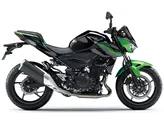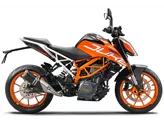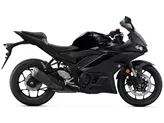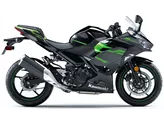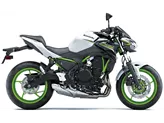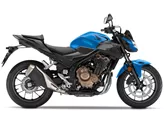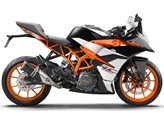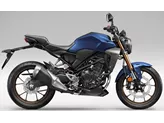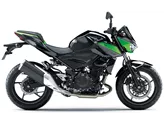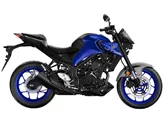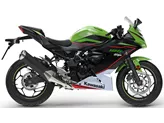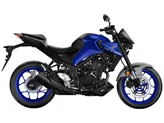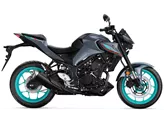Kawasaki Z 400 2019 vs. Kawasaki Ninja 400 2018

Kawasaki Z 400 2019

Kawasaki Ninja 400 2018
Vue d’ensemble - Kawasaki Z 400 2019 vs Kawasaki Ninja 400 2018
The Kawasaki Z 400 2019 and the Kawasaki Ninja 400 2018 are both impressive motorcycles with similar technical specifications. They both feature an inline engine with a bore of 70 mm and a stroke of 51.8 mm, producing 45 horsepower and 38 Nm of torque. The compression ratio is 11.5, and they both have a fuel injection system with a throttle bore of 32 mm. The engines are liquid-cooled and have a displacement of 399 cc.
In terms of suspension, both bikes have a telescopic fork front suspension with a diameter of 41 mm and a swing arm rear suspension with a monoshock absorber. The rear suspension also has preload adjustment. The frames of both bikes are made of steel and have a tubular design. The rake and trail measurements are slightly different, with the Z 400 having a rake of 65.5 degrees and a trail of 92 mm, while the Ninja 400 has a rake of 63 degrees and a trail of 93 mm.
Both bikes have a single disk front brake with a diameter of 310 mm and a double piston caliper. The front brakes also feature petal technology. Additionally, both bikes are equipped with ABS for advanced rider assistance.

Kawasaki Z 400 2019
In terms of dimensions and weights, both bikes have a front tire width of 110 mm and a front tire diameter of 17 inches. The rear tire width is 150 mm, and the rear tire diameter is 17 inches as well. The wheelbase is 1370 mm, and the seat height is 785 mm for both bikes. The kerb weight, including ABS, is 167 kg for the Z 400 and 168 kg for the Ninja 400. Both bikes have a fuel tank capacity of 14 liters.
Now let's discuss the strengths and weaknesses of each bike. The Kawasaki Z 400 2019 has several strengths. It offers a great, very controllable power delivery, making it suitable for novice riders. It also has a low weight and a good seating position, providing a comfortable and enjoyable riding experience. Additionally, it has a great sound, which adds to the overall experience.
On the other hand, the Kawasaki Ninja 400 2018 has its own set of strengths. Its chassis is suitable for sporty use, and its low weight makes it effortless to handle. The engine has a smooth response, and the seating position is relaxed and confidence-enhancing. The bike is also equipped with LED headlights, which provide better visibility.

Kawasaki Ninja 400 2018
In terms of weaknesses, the Kawasaki Z 400 2019 has non-adjustable clutch and brake levers, which may not be suitable for riders with specific preferences. The chassis is also limited in terms of adjustability, which may limit customization options.
Similarly, the Kawasaki Ninja 400 2018 has its own weaknesses. The brake and clutch levers are not adjustable, which may be a drawback for riders who prefer personalized settings. Additionally, riders over 180 cm tall may experience enormously loud wind noise with the original windshield.
In conclusion, both the Kawasaki Z 400 2019 and the Kawasaki Ninja 400 2018 are impressive motorcycles with similar technical specifications. They have their own strengths and weaknesses, making them suitable for different types of riders. The Z 400 is great for novice riders with its controllable power delivery and low weight, while the Ninja 400 offers a sportier chassis and effortless handling. Ultimately, the choice between the two will depend on the rider's preferences and intended use of the motorcycle.
Caractéristiques techniques Kawasaki Z 400 2019 par rapport à Kawasaki Ninja 400 2018
Avantages et inconvénients en comparaison
Avantages et inconvénients en comparaison
Kawasaki Z 400 2019

La Kawasaki Z400 est en tout cas une belle évolution du modèle précédent Z300. Plus de puissance, moins de poids - tout simplement une moto encore meilleure. Le développement linéaire de la puissance et l'excellente maniabilité font de la Z400 une moto idéale pour les débutants. La facilité d'actionnement de l'embrayage et la bonne configuration du châssis vont également dans ce sens, raison pour laquelle la Z400 peut être recommandée sans hésitation aux pilotes débutants.
Kawasaki Ninja 400 2018

En résumé, la Ninja 400 pourrait être considérée comme l'entrée parfaite dans le monde des supersports. Il n'est pas possible d'avoir plus de puissance avec un A2, l'apparence laisse présager beaucoup plus de puissance, le véhicule est ludique à conduire, il est tolérant à tous points de vue et permet malgré tout une conduite vraiment sportive. Ceux qui avaient encore des doutes parfois justifiés sur le manque de puissance des diverses machines de 250 cc n'ont plus d'excuses. Ninja 400, c'est bien que tu sois là !
Comparaison des prix Prix moyen du marché Kawasaki Z 400 vs Kawasaki Ninja 400
There are a few key differences between a Kawasaki Z 400 2019 and a Kawasaki Ninja 400 2018. In terms of price, the actual average price of a Kawasaki Ninja 400 2018 is about 19% higher. A Kawasaki Z 400 2019 experiences a loss of 270 USD in one year of ownership. This is offset by a loss of 130 USD for a Kawasaki Ninja 400 2018. Compared to Kawasaki Ninja 400 2018 there are less Kawasaki Z 400 2019 bikes available on the 1000PS.de Marketplace, specifically 6 compared to 10. It takes less time to sell a Kawasaki Z 400 with 99 days compared to 105 days for a Kawasaki Ninja 400. Since model year 2019 1000PS.de editors have written 8 reviews for the Kawasaki Z 400 and 9 reviews for the Kawasaki Ninja 400 since model year 2018. The first review for the Kawasaki Z 400 was published on 10/2/2018 and now has more than 23,200 views. This compares to more than 44,300 views for the first review on Kawasaki Ninja 400 published on 11/22/2017.


